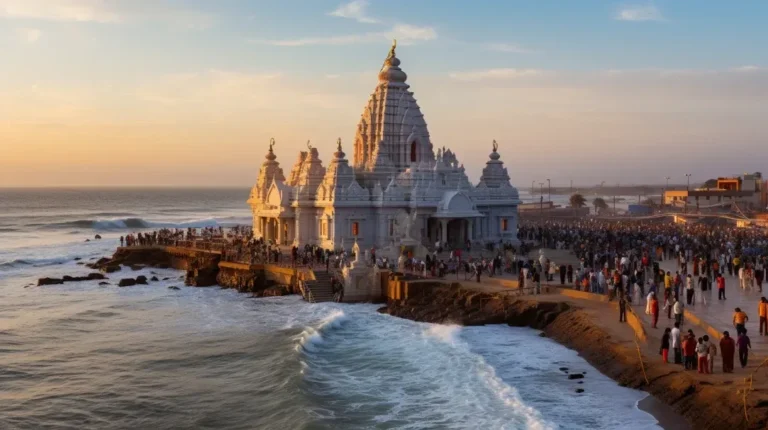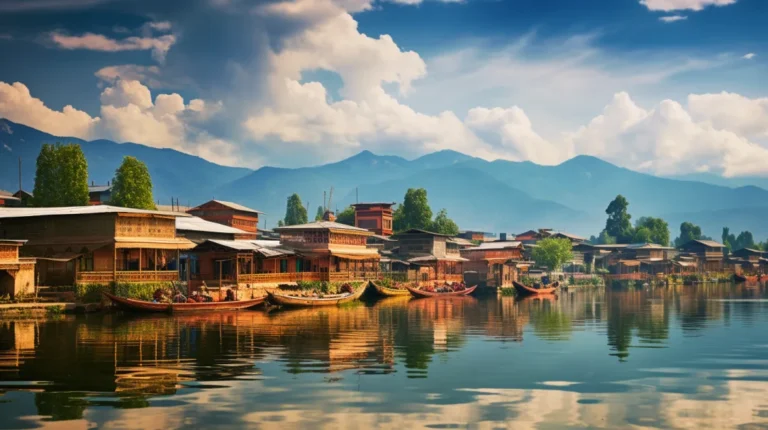Discover India’s Most Revered Pilgrimage Site: A Spiritual Journey Awaits
Embark on a transformative journey to India’s most revered pilgrimage site, where spirituality and devotion converge. This sacred destination holds immense historical significance, offering a glimpse into the rich tapestry of the country’s religious heritage.
Through sacred rituals and vibrant cultural traditions, visitors can immerse themselves in a spiritual experience that transcends time. Marvel at the architectural wonders that grace this hallowed place, reflecting the exquisite craftsmanship of ancient times.
Surrounded by breathtaking natural beauty, this pilgrimage site invites introspection and personal reflection. Delve into the spiritual practices that have guided countless seekers on their quest for enlightenment.
With a carefully curated pilgrimage itinerary, this spiritual journey promises to be a deeply profound and enlightening experience.
Key Takeaways
- Varanasi, also known as Kashi, is one of the oldest continuously inhabited cities in the world and represents the cultural and religious heritage of India.
- The sacred rituals and traditional prayer ceremonies at Varanasi hold deep cultural significance and provide a profound and transformative experience for devotees.
- The architectural marvels of Varanasi’s temples showcase the rich cultural heritage of India and attract visitors from all over the world.
- The spiritual practices and personal reflections experienced in Varanasi offer a unique opportunity for self-reflection, deepening the spiritual journey, and gaining a deeper understanding of one’s purpose in life.
Historical Significance
The historical significance of India’s most revered pilgrimage site is unparalleled, as it holds centuries of cultural and religious heritage.
This sacred place, known as Varanasi, or Kashi, is situated on the banks of the holy river Ganges and is believed to be one of the oldest continuously inhabited cities in the world.
Varanasi is a testament to the rich tapestry of India’s past, with its ancient temples, ghats, and narrow alleyways that have witnessed countless pilgrims seeking spiritual solace.
The city is mentioned in ancient scriptures and has been a hub of learning and spirituality for millennia. It is believed that a journey to Varanasi can wash away one’s sins and lead to salvation.
The historical significance of this sacred site cannot be overstated, as it represents the very essence of India’s cultural and religious heritage.
Sacred Rituals
Embarking on a spiritual journey at India’s most revered pilgrimage site entails partaking in sacred rituals that hold deep cultural significance.
Traditional prayer ceremonies, rooted in ancient traditions, offer devotees a chance to connect with the divine and seek blessings.
These rituals are not mere acts of faith, but symbolic gestures that embody the essence of sacredness, reminding pilgrims of the profound importance of their spiritual quest.
Traditional Prayer Ceremonies
During a visit to India’s most revered pilgrimage site, one can partake in the sacred rituals of traditional prayer ceremonies. These ceremonies are deeply rooted in the country’s rich spiritual traditions and offer a profound and transformative experience for those seeking a deeper connection with the divine.
Here are three captivating aspects of traditional prayer ceremonies that will captivate your spirit:
- Awe-inspiring chants: The rhythmic chanting of hymns and mantras resonates through the air, creating a powerful and meditative atmosphere that transports participants into a state of spiritual bliss.
- Intricate rituals: Witness the intricate rituals performed by the priests, who meticulously follow ancient scriptures and traditions. Each movement and gesture holds deep symbolism, inviting devotees to immerse themselves in the sacredness of the moment.
- Offering of prayers: Witness the devotees offering their heartfelt prayers and petitions to the deity. This act of surrender and devotion creates an atmosphere filled with faith, hope, and a sense of unity.
Participating in these traditional prayer ceremonies is not only a spiritual journey but also a cultural immersion that allows one to truly experience the essence of India’s spiritual heritage.
Symbolism in Rituals
Symbolism plays a significant role in the sacred rituals of India’s most revered pilgrimage site. These rituals are deeply rooted in the country’s rich spiritual traditions and are a way for devotees to connect with the divine.
Every aspect of the rituals, from the choice of offerings to the specific gestures and chants, is carefully chosen to convey deeper meanings and spiritual significance. For example, the lighting of a lamp represents the dispelling of darkness and the awakening of inner wisdom. The offering of flowers symbolizes purity and devotion. The act of circumambulating a sacred site represents a journey of self-discovery and surrender to a higher power.
These symbols not only enhance the spiritual experience but also serve as a reminder of the deeper truths and values that lie at the heart of the pilgrimage.
Importance of Sacredness
The sacred rituals at India’s most revered pilgrimage site hold immense significance in fostering a profound sense of spirituality. These rituals, passed down through generations, serve as a gateway to connect with the divine and seek inner peace.
Here are three key reasons why these sacred rituals are of utmost importance:
- Transcendence: The rituals provide a means to transcend the mundane and enter a realm of higher consciousness. They allow individuals to detach from worldly concerns and immerse themselves in the divine presence.
- Purification: Through the performance of sacred rituals, devotees cleanse their minds, bodies, and souls. The rituals act as a purification process, removing impurities and negative energies, and creating a space for spiritual growth and transformation.
- Communal Unity: The sacred rituals bring people together in a shared experience of devotion and worship. They foster a sense of community, promoting harmony, understanding, and compassion among individuals from diverse backgrounds.
Architectural Marvels
Prepare to be captivated by the architectural marvels that await you at India’s most revered pilgrimage site.
The ancient temple designs are a testament to the rich cultural heritage of the country, showcasing intricate carvings and breathtaking structures that have withstood the test of time.
Each architectural masterpiece holds deep cultural significance, inviting visitors to immerse themselves in the spiritual energy that permeates these sacred spaces.
Ancient Temple Designs
How do ancient temple designs in India showcase unparalleled architectural marvels?
Here are three remarkable aspects that highlight the grandeur and ingenuity of these structures:
- Intricate Carvings: Ancient Indian temples are renowned for their intricate carvings that adorn the walls, pillars, and ceilings. These carvings depict mythological stories, deities, and various aspects of Indian culture, showcasing the remarkable craftsmanship of the artisans.
- Unique Architectural Styles: India boasts a diverse range of temple architectural styles, such as Dravidian, Nagara, and Vesara. Each style exhibits distinctive features, including towering gopurams, elaborate mandapas, and intricately carved vimanas, showcasing the creativity and architectural genius of the time.
- Precision Engineering: Ancient Indian temple designs demonstrate exceptional precision engineering. The structures are built to withstand the test of time, with perfectly aligned pillars, intricate stone joints, and complex structural systems that defy gravity.
These ancient temple designs not only serve as places of worship but also stand as testaments to India’s rich cultural heritage and architectural excellence.
Cultural Significance of Architecture
Continuing the exploration of ancient temple designs, the cultural significance of architecture in India’s architectural marvels is prominently evident. From the intricate carvings on the walls to the towering spires that reach towards the heavens, these structures are not only a testament to the skill and craftsmanship of the builders, but also serve as a reflection of India’s rich cultural heritage. Each architectural marvel tells a story, showcasing the diverse religious and artistic traditions of the country.
The temples are not just places of worship, but also serve as important cultural and historical landmarks, attracting visitors from all over the world. These architectural marvels are a testimony to the spiritual and artistic prowess of the Indian civilization, and continue to inspire awe and admiration.
Transitioning into the subsequent section about ‘natural beauty’, let’s explore how these architectural wonders harmonize with the breathtaking landscapes that surround them.
Natural Beauty
Amidst the sacred grounds of India’s most revered pilgrimage site lies a natural beauty that captivates the soul. The natural surroundings of this divine place are a testament to the country’s rich biodiversity and awe-inspiring landscapes. Here are three reasons why the natural beauty of this pilgrimage site is truly remarkable:
- Lush greenery: The pilgrimage site is enveloped by lush green forests, filled with towering trees and vibrant foliage. Walking through these verdant surroundings, visitors can feel a sense of tranquility and connection with nature.
- Majestic mountains: Nestled amidst breathtaking mountain ranges, the pilgrimage site offers panoramic views that leave visitors in awe. The sight of these majestic peaks, with their snow-capped summits and cascading waterfalls, is truly a sight to behold.
- Serene rivers: The pilgrimage site is blessed with crystal-clear rivers that gently flow through its grounds. The serene sound of flowing water creates a peaceful atmosphere, inviting visitors to reflect and find solace in the soothing presence of nature.
Embrace the natural beauty of this sacred place and let it inspire you on your spiritual journey.
Cultural Traditions
The cultural traditions of India’s most revered pilgrimage site add depth and richness to the spiritual journey. As pilgrims make their way to this sacred place, they are immersed in a vibrant tapestry of customs, rituals, and beliefs that have been passed down through generations.
The air is filled with the scent of incense and the melodious chants of prayers. Colorful processions, adorned with ornate costumes and intricate decorations, captivate the senses and transport visitors to a different time and place.
Devotees partake in various acts of devotion, from making offerings at sacred shrines to participating in sacred ceremonies and rituals. These traditions not only foster a deep connection with the divine but also serve as a reminder of the rich cultural heritage of India.
Spiritual Practices
Pilgrims engage in numerous spiritual practices at India’s most revered pilgrimage site, embracing a range of rituals and customs to deepen their connection with the divine. Here are three powerful spiritual practices that pilgrims undertake:
- Meditation: The pilgrimage site offers serene surroundings, providing the perfect environment for pilgrims to engage in deep meditation. This practice allows individuals to quiet their minds, find inner peace, and connect with their spiritual essence.
- Prayer: Pilgrims offer prayers at the sacred shrines, seeking blessings and guidance from the divine. Through heartfelt prayers, they express their devotion, gratitude, and desires, fostering a deeper connection with the higher power.
- Ritual Bathing: A significant spiritual practice involves bathing in the holy rivers or sacred pools found at the pilgrimage site. The act of immersing oneself in these purifying waters symbolizes the cleansing of sins, purifying the body, mind, and soul.
These spiritual practices create an atmosphere of reverence, devotion, and self-reflection, allowing pilgrims to embark on a profound journey of spiritual growth and transformation.
Pilgrimage Itinerary
Visitors to India’s most revered pilgrimage site can embark on a well-structured itinerary that allows them to experience the sacredness and spirituality of the place.
The pilgrimage itinerary is designed to offer a comprehensive and meaningful journey for individuals seeking a deeper connection to their spiritual selves.
The journey begins with a visit to the holy town, where pilgrims can immerse themselves in the vibrant atmosphere and witness the rituals and traditions that have been practiced for centuries.
From there, pilgrims can proceed to the sacred temples, where they can offer prayers and participate in religious ceremonies.
The itinerary also includes visits to nearby ashrams and meditation centers, providing opportunities for introspection and inner peace.
Throughout the journey, pilgrims are encouraged to reflect on their spiritual path and seek guidance from the spiritual leaders and gurus who reside in the area.
The pilgrimage itinerary offers a transformative experience, allowing visitors to connect with the divine and find a renewed sense of purpose and enlightenment.
Personal Reflections
During their pilgrimage to India’s most revered site, individuals can engage in personal reflections to deepen their spiritual journey.
- Silent Contemplation: The serene ambiance of the pilgrimage site provides the perfect backdrop for introspection. Visitors can find a quiet corner and spend time in deep contemplation, allowing their thoughts to unravel and their innermost questions to be answered.
- Connection with the Divine: The sacred atmosphere of the site offers a unique opportunity to connect with the divine. It is a time for seekers to offer their prayers, express gratitude, and seek guidance. Through this connection, individuals can experience a deep sense of peace and a renewed faith in their spiritual path.
- Self-Realization: The pilgrimage journey allows individuals to detach from the distractions of everyday life and focus on their inner self. This introspection can lead to self-discovery and self-realization, as pilgrims gain a deeper understanding of their purpose and their place in the world.
Engaging in personal reflections during the pilgrimage can be a transformative experience, guiding individuals towards a more profound spiritual connection and a greater sense of inner fulfillment.
Frequently Asked Questions
How Much Does It Cost to Visit the Pilgrimage Site?
The cost of visiting the pilgrimage site varies depending on factors such as accommodation, transportation, and duration of stay. It is advisable to research and plan ahead to get a better understanding of the expenses involved in undertaking this spiritual journey.
Are There Any Restrictions on Photography or Videography at the Site?
Photography and videography at the site are subject to certain restrictions. While capturing the spiritual journey can be enticing, it is important to respect the sanctity of the pilgrimage site and adhere to the guidelines set by the authorities.
What Is the Best Time of Year to Visit the Pilgrimage Site?
The best time to visit the pilgrimage site is during the winter months, from November to February, when the weather is cool and pleasant. This period allows for a more comfortable and enjoyable spiritual journey.
Are There Any Accommodation Options Available Near the Pilgrimage Site?
There are several accommodation options available near the pilgrimage site, ranging from budget-friendly guesthouses to luxury hotels. Visitors can choose from a variety of accommodations that cater to different preferences and budgets.
Are There Any Specific Clothing Requirements or Dress Codes for Visitors at the Site?
Visitors to the pilgrimage site are expected to adhere to specific clothing requirements and dress codes. Modest attire is recommended, covering shoulders, knees, and heads for both men and women, in order to show respect and maintain the spiritual atmosphere.
Conclusion
India’s most revered pilgrimage site offers a profound spiritual journey, where history, sacred rituals, architectural marvels, natural beauty, cultural traditions, and spiritual practices converge.
This sacred place holds significant historical importance and showcases stunning architectural wonders.
The tranquil surroundings and awe-inspiring natural beauty create a serene atmosphere for deep reflection and introspection.
Immerse yourself in the rich cultural traditions and experience the transformative power of the spiritual practices.
Embark on this pilgrimage itinerary to embark on a soul-stirring adventure that will leave an indelible mark on your heart and mind.







